Part 25: NSIC 07: Umbran-Style Exploding Implosion!

NSIC 07: Umbran-Style Exploding Implosion! Blip(Polsy) | Youtube(Polsy) | Download

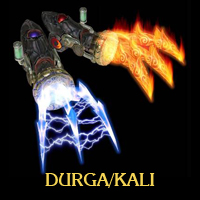
Durga/Kali
The soul of Durga/Kali, said to be a demon with a thousand arms, is imprisoned within these razor sharp claws. From the portal at its hilt, the weapon can summon two types of arms, fire and lightning, to bear against its enemies.
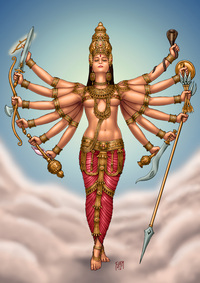
Durga Devi, by SleinadFlar
Durga and Kali both have the same in-game description, and their associated gods are either very closely related, or the same, depending on what Hindi mythology you look at.
Durga "the invincible" or "the inaccessible", is a fierce form of the radiant goddess Devi in Hindu mythology. She is considered to be the Divine Mother, or the core form of every Hindu goddess. She is depicted with many arms, up to eighteen, carrying various weapons and riding either a lion or a tiger. She is often pictured as battling or slaying demons, particularly Mahishasura, the buffalo demon.
According to a narrative in the Devi Mahatmya story of the Markandeya Purana text, Durga was created as a warrior goddess to defeat Mahishasura. Mahishasura was an asura, able to change between human and buffalo form at will, due to his lineage (mahisha is the Sanskrit word for buffalo). His father was Rambha, king of the asuras, and his mother was Shyamala, a princess cursed to be a buffalo. Oddly enough, Brahma, a Deva (remember, the good guys) gave Mahishasura invincibility to all men. Do you see where this is going yet?
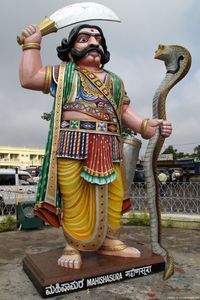
A statue of Mahishasura in Chamundi Hills, Mysore
The Devas and Asuras often wage wars against each other. In one such war, Rambha was killed by Indra. Remember that dude that killed Vritra? Killing asuras is his favourite pasttime. As Mahishasura grew up, he came to know how his father died. Wishing to get revenge on the devas, he banded together his loyal soldiers and began an assault on Heaven. He was able to defeat Indra, and drive all the Devas out of heaven.
Shiva, realizing that no man or god (male) can defeat Mahishasura, pleaded to his wife Parvati to take the role of a female goddess warrior in order to slay the demon. Parvati, now Durga, combined the powers of all the devas in a beautiful form. Each of her weapons was given to her by a different god: Vishnu's discus; Shiva's trident; Varuna's conchshell; Agni's flaming dart; Vayu's bow; Surya's quiver and arrow; Yama's iron rod; Indra's thunderbolt; Kubera's club and a garland of snakes from Shesha and a lion as a charger from the Himalayas. Now fully armed, she marched against the demon Mahishasura.
Now, for a c&p job from Wikipedia:
Wikipedia posted:
To combat the evil Mahishasura, [Durga] had appeared in a great blinding light, to combat this demon and end it for all to be in peace. Mahishasura had gravely underestimated her, thinking: "How can a woman kill me, Mahishasur — the one who has defeated the trinity of gods?". However, Durga roared with laughter, which caused an earthquake which made Mahishasur aware of her powers.
Despite that, the terrible Mahishasura rampaged against her, changing forms many times. At first, he was a buffalo demon, and she defeated him with her sword. Then he changed forms and became an elephant that tied up the goddess's lion and began to pull it towards him. The goddess cut off his trunk with her sword. The demon Mahishasur continued his terrorizing, taking the form of a lion, and then the form of a man, but both of them were gracefully slain by Durga.
Then Mahishasur began attacking once more, starting to take the form of a buffalo again. The patient goddess became very angry, and proclaimed to Mahishasur in a colorful tone—"Roar with delight while you still can, O illiterate demon, because when I will kill you, the gods themselves will roar with delight."
When Mahishasur had half emerged into his buffalo form, he was paralyzed by the extreme light emitted from the goddess's body. The goddess then resounded with laughter before cutting Mahishasur's head down with her sword.
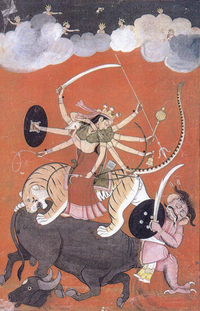
And so, Durga slew Mahishasura, and became known as Mahishasuramardini (literally the slayer of the buffalo demon), the destroyer of Mahishasura. Her victory is celebrated annually in the festivals of Navaratri and Durga Puja.
In this story, Durga is the alternate form of Parvati, Shiva's consort. However, in other Hindu religions, Durga can also be another form of the goddess Shakti.
First, to explain, Hinduism is not an all-encompassing religion. In the same way that Christianity has branching religions like Catholicism, Protestantism, Lutherenism etc, Hinduism has many branching sects. The main branches of Hinduism (Vaishnavism, Shaivism and Shaktism) each worship different gods; Vishnu, Shiva and Shakti/Devi respectively.
Shakti, from Sanskrit meaning, 'to be able', is the concept, or personification, of divine female creative power, sometimes referred to as 'The Great Divine Mother' in Hinduism. In Shaktism, Shakti is worshipped as the Supreme Being. However, in other Hindu traditions of Shaivism and Vaishnavism, Shakti embodies the active feminine energy, or nature, of Purusha (the 'Cosmic Man'). In Vaishnavism, this is Vishnu, and in Shaivism it's Shiva. Vishnu's female counterpart is called Lakshmi, with Parvati being the female half of Shiva.
So, what this basically boils down to, is that Durga is an alternate form of Shakti in Shaktism, and also Parvati in Shaivism. But, Durga is not an alternate form of Lakshmi, despite the fact that she is how Shakti is represented in Vaishnavism! Don't forget that Parvati and Shakti are just different names for Shakti. You are allowed to be confused.
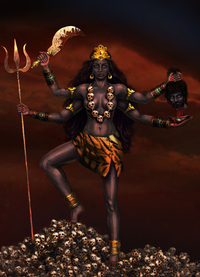
Kali "She who Destroys", also known as Kalika, is the consort of Shiva. She is the many-armed Hindu goddess of death and destruction associated with limitless and eternal energy.
Kali is the feminine form of kala. Kala primarily means "time" but also means "black" in honor of being the first creation before light itself. Kali means "the black one" and refers to her being the entity of "time" or "beyond time." Kali is strongly associated with Shiva, and Shaivas derive the masculine Kala (an epithet of Shiva) to come from her feminine name.
Kali's most famous legend tells how Durga tries to wound the asura Raktabija in an attempt to destroy him. However, Raktabija was able to duplicate himself from every drop of his blood that was spilled (rakta meaning blood, bija meaning seed; "he for whom each drop of blood is a seed"). Durga soon finds herself overwhelmed with the sheer number of demons surrounding her. She then assumes the form of Kali. So Parvati -> Durga -> Kali.
Out of the surface of her (Durga's) forehead, fierce with frown, issued suddenly Kali of terrible countenance, armed with a sword and noose. Bearing the strange khatvanga (skull-topped staff ), decorated with a garland of skulls, clad in a tiger's skin, very appalling owing to her emaciated flesh, with gaping mouth, fearful with her tongue lolling out, having deep reddish eyes, filling the regions of the sky with her roars, falling upon impetuously and slaughtering the great asuras in that army, she devoured those hordes of the foes of the devas.
Kali then kills Raktabija by dancing over to him, slicing open his throat, and drinking his blood. Pleased with her victory, Kali then dances on the field of battle, stepping on the corpses of the slain.
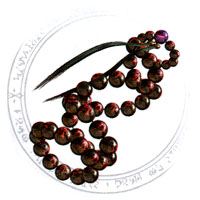
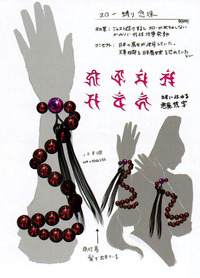
Evil Harvest Rosary
Magical beads crafted by the witch Akko while in the service of the ancient Japanese queen Himiko. When its user dodges incoming danger, the beads will launch a magical counter-strike against the attacker. While the attack is incredibly powerful, it sucks the emotional strength from its user, stripping them of the ability to activate Witch Time.
The term rosary is probably most commonly associated with the Catholic Marian devotion of repeated sequences of prayer. It can also refer to the beads used to count the prayers. However, the Evil Harvest Rosary (EHR) seems to be modelled on zen buddhist prayer beads. Prayer beads serve to count the repetitions of prayers, chants or devotions.
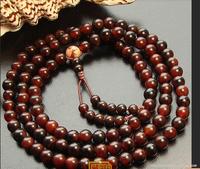
The structure of prayer beads can vary depending on the religion. Buddhist beads use the Japa Mala which usually has 108 beads, or 27 beads counted four times. The number 108 has special religious significance in both Buddhist and Hindu traditions. Traditional Buddhist thought believes that people have 108 afflictions. There are six senses (sight, sound, smell, taste, touch, and consciousness) multiplied by three reactions (positive, negative, or indifference) making 18 "feelings." Each of these feelings can be either "attached to pleasure or detached from pleasure" making 36 "passions", each of which may be manifested in the past, present, or future. All the combinations of all these things makes a total of 108, which are represented in the prayer beads.
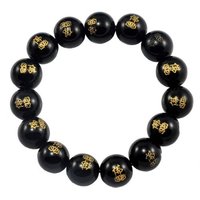
Various type of materials are used to make mala beads such as seeds of the rudraksha tree, beads made from the wood of the tulasi plant, animal bone, wood or seeds from the Bodhi tree or seeds of the lotus plant. Semi-precious stones like carnelian and amethyst is also used. Another commonly used material is sandalwood. Note that the Bodhi tree is significant in Buddhism as it is the sacred fig tree under which Siddhartha Gautama, the spiritual teacher later known as Gautama Buddha, achieved enlightenment.
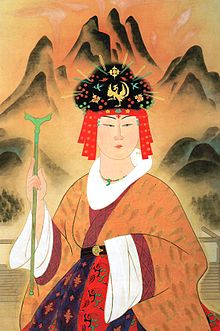
Himiko, Queen of Yamataikoku, ruled from 189 CE – 248 CE
The description for the EHR mentions two names; Akko and Himiko. A cursory google search doesn't provide anything useful for Akko, unless you count magical girl anime and references to Acre, but Himiko is a different story. Himiko is an obscure shaman queen of Yamataikoku in ancient Wa (Japan). Shamanism is the practice of using altered states of consciousness to encounter, influence and interact with the spirits, both benevolent and malevolent. I suppose that in that regard, she could be considered a witch. Himiko is not documented in neither of the two oldest Japanese history records (Kojiki "Records of Ancient Matters", 712, and Nihon Shoki "Chronicles of Japan", 720). It is possible that despite knowing about Himiko, she was purposefully not included by the authors. One exception to this is in Nihon Shoki, where she is mentioned by title (the King/Queen/ruler of Wa), but not by her name.
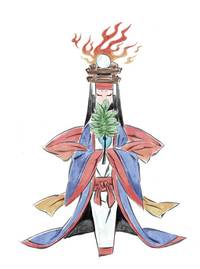
Queen Himiko's sorrow
Himiko here could possibly be a reference to one of Kamiya's other games, Okami. Set in an alternative ancient Japan called Nippon, the Himiko in Okami is the Queen of Sei'an City, which is covered with a could of paralyzing poisonous mist. Upon entering Sei'an, Okami Amaterasu (Ammy), the protaganist, is shocked to discover that despite the citizens' suffering, Himiko is doing nothing to help her people. When Ammy is finally able to meet Himiko, it is revealed that she has been praying fervently for Ammy's arrival. Himiko's appearance in the game could be described as shaman-like, a possible link to her real-life counterpart.